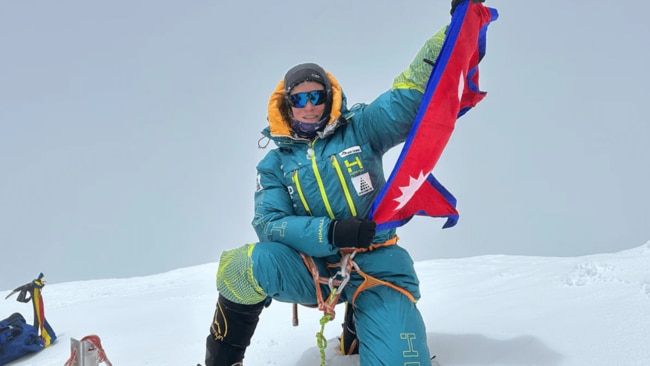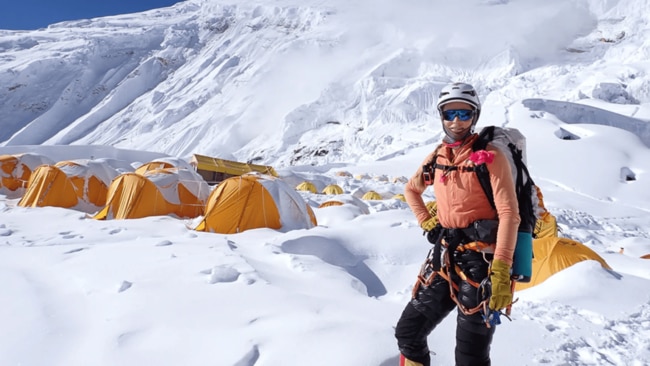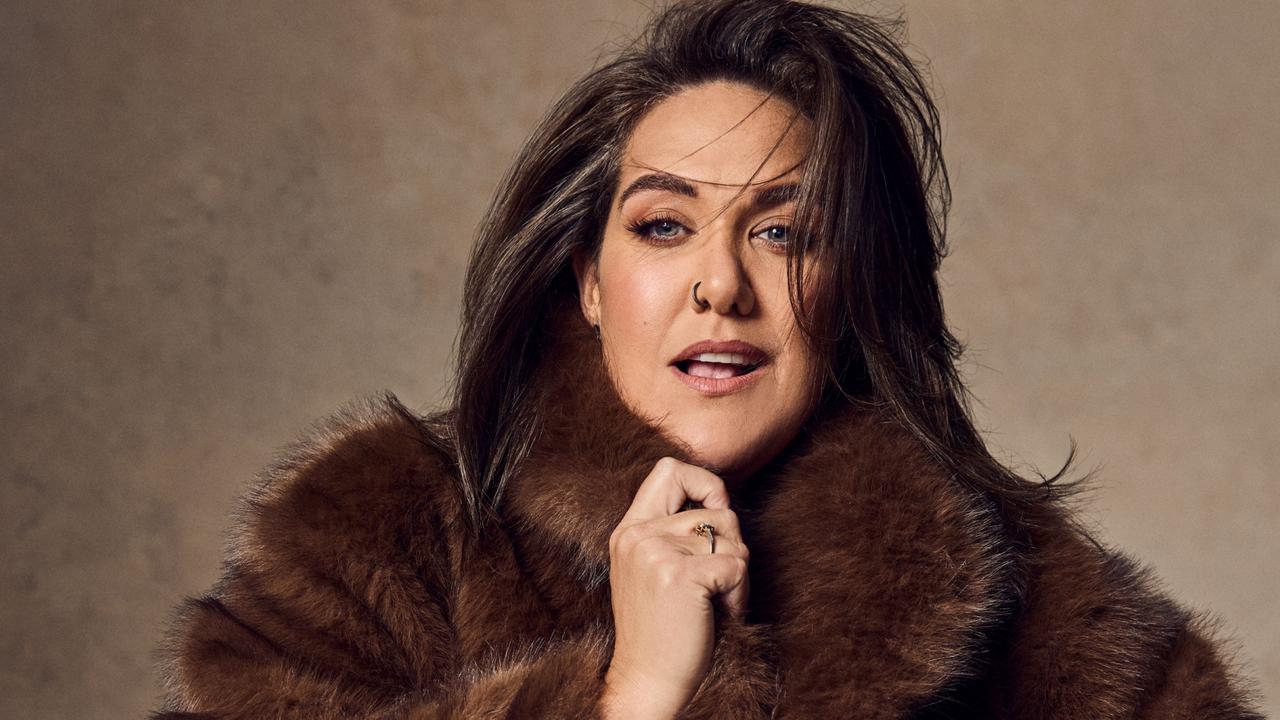Mountaineering legend, Allie Pepper on finding her passion and handling the pressure
She's on a mission

Lifestyle
Don't miss out on the headlines from Lifestyle. Followed categories will be added to My News.
In 2024, Allie Pepper summited Makalu, reaching the highest altitude of any Australian woman without oxygen at 8485m. Now on a mission to climb all 14 of the world’s 8000m peaks, she shares her secrets to remaining cool under pressure and redefining life after menopause.
You’re the first Australian woman to climb the mountains of Broad Peak, Annapurna and Makalu without oxygen. At over 8000m in elevation, this is incredibly dangerous work. What’s the scariest moment you’ve encountered and how did you overcome it?
I have been in a storm close to 8000m where I didn’t know we would survive. It was scary, I literally stared death in the face and thought, ‘Ok, we’re going to die here. We can’t find the way back, we don’t know which way to go. It’s a white out, it’s a storm, it’s freezing cold.’ In that moment, I had to surrender and that was it. What else can you do? We were there for three hours, then the clouds lifted and we were able to see the way.
Not only did we save ourselves, we saved a whole other group of people who were lost in the storm and helped them back to camp. That happened in 2022, which was before I started to do mindset work. That was a super stressful situation and I didn’t want to be in it again – ever. I feel as though the more inner work I do, the less I have had to deal with that type of situation on the mountain and the more I’ve avoided it.
Off the mountains, how has this mindset and inner work helped you overcome life’s obstacles?
It’s my comfort zone on the mountain. I know that sounds crazy, but that’s the world I’ve spent a lot of time in and I feel at home there. What has been a challenge is bringing that to my normal life… it’s been a real journey. I had a mid-life crisis. My father passed away during Covid, I’m an only child and that hit me very hard.
Menopause hit me and that was life-changing, as it is for a lot of women. I had very strong symptoms; depression, I couldn’t sleep, night sweats, brain fog, it was very difficult to train as I couldn’t recover and I didn’t think I’d climb again. It wasn’t until I found the right medication in menopause therapy that I started to change my body back and I got my life back.
I felt myself again, then I went through a marriage breakdown and a divorce. I went very much into the victim consciousness of ‘Why me? Why is this all happening to me?’ and it forced me to go within. I wasn’t on the mountain and it made me realise that I’m the one who is in control of my destiny, the one who is responsible for how I think about myself, for what I believe about myself. That made me decide to invest time and money on my personal growth and healing.

The dream of climbing the 14 peaks first came to you after summiting Cho Oyu in Tibet where you were faced with the decision of making the 8000m climb alone or calling it quits after your climbing partner got frostbite. What advice would you give others on overcoming fears in the pursuit of their dreams?
The comfort zone is the killer of your dream. We might choose what we think is an easy path. Maybe it’s a stable job or staying with a person that you know isn’t right for you but you feel like it’s easier than leaving. But underneath, it’s harder because in your heart, you know that it’s not right for you. When I look back, all these things that I’ve done – I got divorced, went through menopause, I sold my house in pursuit of this dream – I got really uncomfortable and knew this is the next step for me to evolve. Then I see the rewards – to become Australia’s most accomplished female mountaineer is the dream I’ve had for a long time – and I’ve done it. It’s beyond happiness. I feel fulfilled.
You grew up in the Blue Mountains which is famously home to some of Australia’s best hikes and climbs. How did this upbringing shape you into the mountaineer you are today?
I grew up with a lot of nature around me and my Dad was in the conservation society and we used to hike and go into the bush. I grew up being a tomboy, I was more interested in climbing trees and hanging out with the boys. In saying that, when I went to high school at Katoomba High, they didn’t offer any outdoor course or education at all. It was all academic subjects which I just didn’t enjoy. So it wasn’t really until I came back from a spiritual journey in India and Nepal in 1997 that I wanted to find the thing that lights me up. I wanted a career but had never had one, I was just doing casual jobs and stuff like that. It wasn’t really until I decided I wanted to do something that I went to TAFE at 23 and looked at all the brochures. I was a bit of a hippie and wanted to recreate myself and read a brochure that said “Outdoor recreation”. I read it wrong! I thought, ‘I want to recreate myself!’
I loved the outdoors. I’d been fruit picking, living in a tent, and travelling. But I wanted to recreate myself and thought, ‘that’s the course for me.’ That decision changed my life. Then, I learned that where I grew up there was canyoning and rock climbing and all these things I was naturally good at. I picked everything up straight away and topped the class. I started working, guiding, and it took me to New Zealand for a mountaineering course in under a year. I just hadn’t had the opportunity to know that it was my thing. I think these days when kids go to school - not just private, but government too - there’s a range of subjects and things they can try.

There is a lot of pressure on people to find their passion and know what they want to do immediately out of school. Did you feel that in the years before you found mountaineering?
Inside me, I felt like a failure because I didn’t know. I was looking outside of myself to find the thing that would fill the void of that feeling like I’m not enough because I didn’t know what I wanted to do. That led me to end up in India and travel around. I searched and went to a huge ashram, I went to all these different places which is funny, because all these places encourage you to look within but I was on such a mission to look outside of myself.
As a mountaineer, you tackle some of the world’s most challenging terrain, while also facing obstacles like unpredictable weather conditions. How do you mentally and physically train for a sport in which the variables are so hard to control?
It’s one of those sports that’s so far on the edge it’s almost difficult to call it a sport. There’s so many variables and especially what I do - climbing without oxygen - it’s a fine line. There’s not that many sports where if you make a wrong decision, you die. It’s at the extreme end and it takes a lot of experience.
Being in that environment for many years and learning what it takes to survive in that environment and what it means when the snow looks like this, or the weather does that, and how that changes the snow pack, whether we should go up or go down - that’s all external.
Then, there’s how you’re feeling inside as well. I have to be strong, I have to be healthy. The minute I get a chest infection, it’s over. There’s a lot of things to think about physically and externally, but at the end of the day, if your mindset is not fortified, there are so many reasons to turn around. It’s so uncomfortable. It’s cold, you can hardly breathe, you can hardly take a step, and you can hardly think. Every single part of your physical body wants to be in comfort and your mind, if it can’t overcome that, then you turn back. It’s very much on the limit; you’re on the edge of thinking ‘what am I capable of?’ and you’re pushing it with each step. It keeps getting further away and then all of a sudden the day is over and you’re back at base camp.
You have a sherpa with you on your climbs who in many ways holds your safety in their hands. What’s the key to great teamwork in such high-stakes situations?
I climb with my partner. He is a sherpa, his name is Mikel Sherpa and we met on the mountains. We’ve since summited five 8000m mountains together. It could go one of two ways climbing with your partner - it could be a disaster! But it’s the total opposite. We trust each other and have this connection, we respect each other, there’s no arguments, we make decisions together, I don’t question him, he doesn’t question me, and it just works. He’s very much dedicated to me fulfilling this dream. I’ve never met anyone in my life who has ever worked so hard for me to fulfill my purpose and my mission. He one-hundred percent supports me. What we say is: I love myself, he loves himself, we love each other, and we love the mountain.
You’re currently embarking on a project to climb the true summits of all 14 of the world’s 8000m peaks without additional oxygen in the world’s fastest time. What inspired the challenge?
In 2007, after seven years of mountaineering and spending a lot of time climbing in the Andes of South America guiding expeditions and climbing technical peaks, gaining a lot of skills and experience at high altitude, I decided to take on my first 8000m mountain. I went there with my climbing partner who was a guide also working at the Blue Mountains and he got some frostbite on his toe and ended up not going up from the base camp to the summit. I had a decision to make: do I go up alone or call it quits? I decided to go up on my own. I borrowed a sat-phone, called my Dad and told him we were going up together which was a lie. I went up alone and ended up summiting completely alone. No one on that day went to the summit at all, I had to make the steps myself, it was very difficult, there was a lot of new snow, but I made it to the summit alone without oxygen.

I came back down and felt as though I’d won the Olympics. It was so hard but I realised, this woman from Australia - who knew - had a gift to climb up 8000m without oxygen. It was a gift, but at the time it was a blessing and a curse. When I came down from that, I had a seed planted inside me because I discovered ‘Oh my god, I’m actually good at this’ and now I want to climb all of them without oxygen. If I can do one, it made me want to do more.
But the curse comes in because at the time I was working as a guide which was one of the lowest paid jobs in Australia, and I just didn’t know how I was going to do this project. It’s a huge undertaking, not just physically but financially, too. It’s not possible to work a 9 to 5 job and do this, too. In my soul I knew this was my calling and what I was meant to do. I’m like an Olympic athlete in this sport and didn’t even know I would be. But it’s taken that many years to grow into the woman that I believe can achieve it.
I imagine even putting it out there that you want to achieve this is somewhat nerve-wracking. Was that a hard thing for you? Who is the first person you tell and how does it transpire into this thing you put out into the world?
After my mid-life crisis, I knew I wanted to get out of this and did an eight-week meditation course which began to rewrite all my limiting beliefs in my brain. There were meetings where you could go and it was so scary for me. I introduced myself and whispered, ‘I have a dream, I want to climb all these mountains without oxygen and I know in my heart I can do it but I don’t believe I’m good enough.’ It makes me cry now, I was just shivering in my voice and couldn’t even say it. Everyone was like, ‘Wow, you’re amazing already. You’ve climbed Everest!’ I was so in my own head of thinking I was a failure and these people that didn’t even know me gave me such a reality check. These people think it’s amazing and want me to do it, who cares if I don’t actually make it in the end. Because it’s not about achieving the thing at the end of the day, it’s just giving it a go.
More Coverage
Originally published as Mountaineering legend, Allie Pepper on finding her passion and handling the pressure




